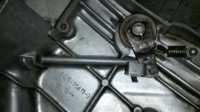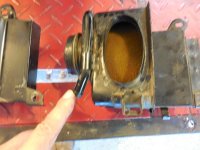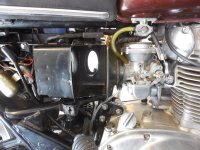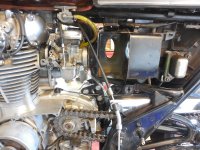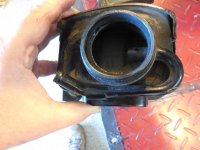More left-side case cover weirdness.
Apparently, Yamaha was making changes to the really early covers so fast and furiously that they didn’t even try to document all of them or assign them different part numbers.
As has been already noted, the early covers did not have the shift pattern cast in next to the shift shaft hole. Well, the really early covers also didn’t have the “Made in Japan” casting. So, the very first covers had no cast-in labeling at all, then they added “Made in Japan” at some time during 1971 (?), and finally, they added the shift pattern, around 72-73?
Obviously, the location of the bottom, rear, mounting bolt hole changed when they added the electric starter. But here is a version where a bung for the new bolt hole location has been added, but it’s not drilled out, and the kick-only bolt hole location is still being used. For me, this cover is an aberration that does not neatly fit into the cover time-line. Maybe these were specially created on an as-needed basis from 72 and later castings to accommodate 70 and 71 owners who needed replacements for covers that they had damaged?
The location for the clutch adjuster spring’s anchor point went through three changes. This is the final location.
That location was preceded by this location, used in 1971. Just a subtle re-positioning -- unlike in the previous picture, this anchor point is centered on the reinforcing gusset. Note the un-used bung.
That un-used bung in the previous pic is the original spring anchor point location, used in 1970.
There are several other features of the 70 and 71 covers that make them unique to later covers, but they are minor.
The back-sides of these covers have part numbers cast into them. The earliest number that I know of is 256-15411, with an additional -1 on a separate line. I am just about certain that this designates part number 256-15411-01. The -1 casting is found on covers with both of the two earliest adjustment spring anchor locations. To reiterate, the very earliest covers have the 256-15411 -1 casting, no shift pattern casting, no “Made in Japan” casting, the “kick-only” bottom, rear, bolt hole location, and no additional, but un-drilled bung that will become the new e-start bottom rear bolt hole location. Covers with this part number stamp can have either of the two earliest spring anchor positions.

The next cast-in part number that I know of is 306-15411-0 with an additional -2 on a separate line. Undoubtedly, this designates part 306-15411-02. This casting began in 1972, and therefore marks the advent of castings that have a bung for the new, bottom, rear, e-start, mounting bolt hole location (whether or not the new bung was actually drilled out and used). They made lots of changes to this cover without bothering to change the part number on the mold. All of these covers have the “Made in Japan” casting. The earliest still don’t have the shift pattern casting, but this was soon added. These covers come in both square- and round corner iterations, and they come with and without oiler holes.

The final cast-in part number that I know of is 306-15411-04. These covers are differentiated from all of the earlier covers by having a screwdriver pry-off groove below the clutch adjuster cover. This cover likely came out in mid-1975. 306-15411-04 was superseded by 584-15411-00-00 in the parts manuals, but they never bothered to update the number in the casting molds, i.e. 306-15411-04 is the last number that you will find on a left-side case cover. I have no idea how a 306-15411-04 cover differs from a 584-15411-00-00 cover, if at all.


